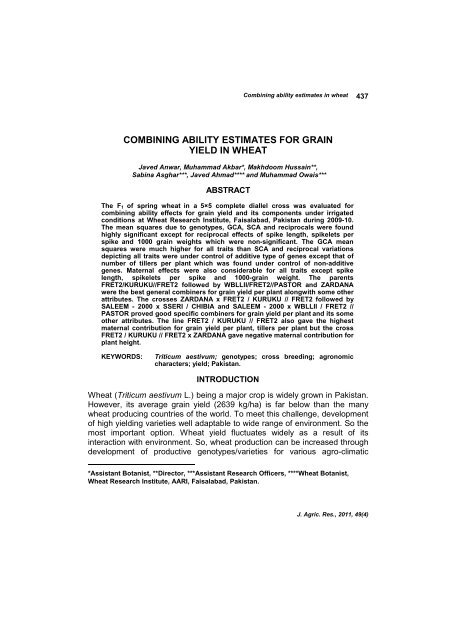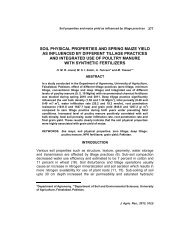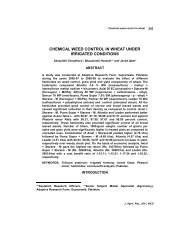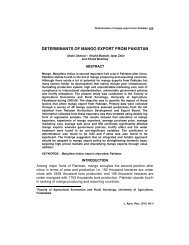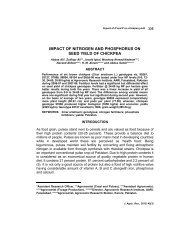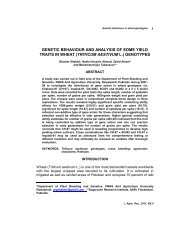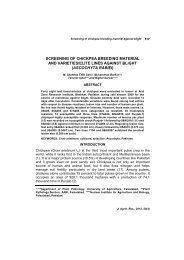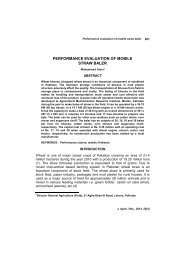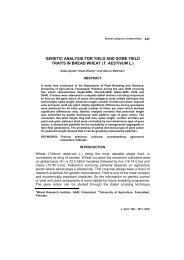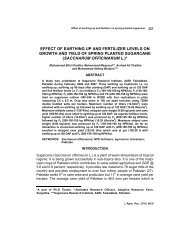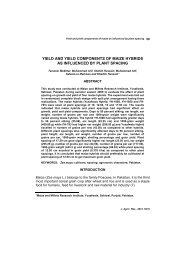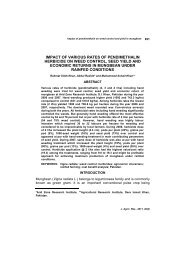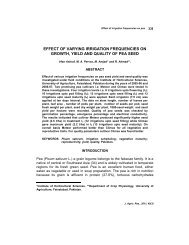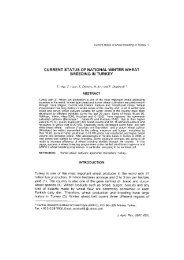combining ability estimates for grain yield in wheat - Journal of ...
combining ability estimates for grain yield in wheat - Journal of ...
combining ability estimates for grain yield in wheat - Journal of ...
Create successful ePaper yourself
Turn your PDF publications into a flip-book with our unique Google optimized e-Paper software.
Comb<strong>in</strong><strong>in</strong>g <strong>ability</strong> <strong>estimates</strong> <strong>in</strong> <strong>wheat</strong><br />
437<br />
COMBINING ABILITY ESTIMATES FOR GRAIN<br />
YIELD IN WHEAT<br />
Javed Anwar, Muhammad Akbar*, Makhdoom Hussa<strong>in</strong>**,<br />
Sab<strong>in</strong>a Asghar***, Javed Ahmad**** and Muhammad Owais***<br />
ABSTRACT<br />
The F 1 <strong>of</strong> spr<strong>in</strong>g <strong>wheat</strong> <strong>in</strong> a 5×5 complete diallel cross was evaluated <strong>for</strong><br />
<strong>comb<strong>in</strong><strong>in</strong>g</strong> <strong>ability</strong> effects <strong>for</strong> <strong>gra<strong>in</strong></strong> <strong>yield</strong> and its components under irrigated<br />
conditions at Wheat Research Institute, Faisalabad, Pakistan dur<strong>in</strong>g 2009-10.<br />
The mean squares due to genotypes, GCA, SCA and reciprocals were found<br />
highly significant except <strong>for</strong> reciprocal effects <strong>of</strong> spike length, spikelets per<br />
spike and 1000 <strong>gra<strong>in</strong></strong> weights which were non-significant. The GCA mean<br />
squares were much higher <strong>for</strong> all traits than SCA and reciprocal variations<br />
depict<strong>in</strong>g all traits were under control <strong>of</strong> additive type <strong>of</strong> genes except that <strong>of</strong><br />
number <strong>of</strong> tillers per plant which was found under control <strong>of</strong> non-additive<br />
genes. Maternal effects were also considerable <strong>for</strong> all traits except spike<br />
length, spikelets per spike and 1000-<strong>gra<strong>in</strong></strong> weight. The parents<br />
FRET2/KURUKU//FRET2 followed by WBLLII/FRET2//PASTOR and ZARDANA<br />
were the best general comb<strong>in</strong>ers <strong>for</strong> <strong>gra<strong>in</strong></strong> <strong>yield</strong> per plant alongwith some other<br />
attributes. The crosses ZARDANA x FRET2 / KURUKU // FRET2 followed by<br />
SALEEM - 2000 x SSERI / CHIBIA and SALEEM - 2000 x WBLLII / FRET2 //<br />
PASTOR proved good specific comb<strong>in</strong>ers <strong>for</strong> <strong>gra<strong>in</strong></strong> <strong>yield</strong> per plant and its some<br />
other attributes. The l<strong>in</strong>e FRET2 / KURUKU // FRET2 also gave the highest<br />
maternal contribution <strong>for</strong> <strong>gra<strong>in</strong></strong> <strong>yield</strong> per plant, tillers per plant but the cross<br />
FRET2 / KURUKU // FRET2 x ZARDANA gave negative maternal contribution <strong>for</strong><br />
plant height.<br />
KEYWORDS:<br />
Triticum aestivum; genotypes; cross breed<strong>in</strong>g; agronomic<br />
characters; <strong>yield</strong>; Pakistan.<br />
INTRODUCTION<br />
Wheat (Triticum aestivum L.) be<strong>in</strong>g a major crop is widely grown <strong>in</strong> Pakistan.<br />
However, its average <strong>gra<strong>in</strong></strong> <strong>yield</strong> (2639 kg/ha) is far below than the many<br />
<strong>wheat</strong> produc<strong>in</strong>g countries <strong>of</strong> the world. To meet this challenge, development<br />
<strong>of</strong> high <strong>yield</strong><strong>in</strong>g varieties well adaptable to wide range <strong>of</strong> environment. So the<br />
most important option. Wheat <strong>yield</strong> fluctuates widely as a result <strong>of</strong> its<br />
<strong>in</strong>teraction with environment. So, <strong>wheat</strong> production can be <strong>in</strong>creased through<br />
development <strong>of</strong> productive genotypes/varieties <strong>for</strong> various agro-climatic<br />
*Assistant Botanist, **Director, ***Assistant Research Officers, ****Wheat Botanist,<br />
Wheat Research Institute, AARI, Faisalabad, Pakistan.<br />
J. Agric. Res., 2011, 49(4)
438<br />
J. Anwar et al.<br />
conditions. One <strong>of</strong> the important breed<strong>in</strong>g strategies is cross<strong>in</strong>g the good<br />
general <strong>comb<strong>in</strong><strong>in</strong>g</strong> l<strong>in</strong>es <strong>for</strong> <strong>gra<strong>in</strong></strong> <strong>yield</strong> and select<strong>in</strong>g transgressive<br />
segregants from its result<strong>in</strong>g segregat<strong>in</strong>g generations.<br />
In<strong>for</strong>mation regard<strong>in</strong>g general and specific <strong>comb<strong>in</strong><strong>in</strong>g</strong> <strong>ability</strong> <strong>of</strong> <strong>wheat</strong><br />
genotypes is a prerequisite to launch a successful <strong>wheat</strong>-breed<strong>in</strong>g<br />
programme. Diallel mat<strong>in</strong>g design has been extensively used to analyze the<br />
<strong>comb<strong>in</strong><strong>in</strong>g</strong> <strong>ability</strong> effects <strong>of</strong> <strong>wheat</strong> genotypes and also to provide <strong>in</strong><strong>for</strong>mation<br />
regard<strong>in</strong>g genetic mechanisms controll<strong>in</strong>g <strong>gra<strong>in</strong></strong> <strong>yield</strong> and other traits.<br />
Knowledge <strong>of</strong> general and specific <strong>comb<strong>in</strong><strong>in</strong>g</strong> abilities (GCA, SCA)<br />
<strong>in</strong>fluenc<strong>in</strong>g <strong>yield</strong> and its components has become <strong>in</strong>creas<strong>in</strong>gly important <strong>for</strong><br />
plant breeders <strong>in</strong> the choice <strong>of</strong> suitable parents <strong>for</strong> develop<strong>in</strong>g potential<br />
possess<strong>in</strong>g varieties <strong>in</strong> many crop plants (11,14,15, 17).<br />
Majority <strong>of</strong> genetic variances <strong>of</strong> <strong>gra<strong>in</strong></strong> <strong>yield</strong> as well as <strong>yield</strong> components have<br />
been reported under control <strong>of</strong> additive genes (5, 8), while number <strong>of</strong> tillers<br />
per plant has been reported <strong>in</strong> control <strong>of</strong> non-additive gene effects <strong>in</strong> earlier<br />
f<strong>in</strong>d<strong>in</strong>gs (1, 10, 16). Both <strong>estimates</strong> were significant <strong>for</strong> most <strong>of</strong> the analysed<br />
traits. The magnitude <strong>of</strong> SCA was reported lower than GCA but rema<strong>in</strong>ed<br />
significant (5, 8). Higher GCA to SCA variance ratio <strong>in</strong>dicated preponderance<br />
<strong>of</strong> additive gene action (3).<br />
The variances due to GCA and SCA and reciprocal effects were significant<br />
<strong>for</strong> all the characters except the reciprocal effects <strong>for</strong> 1000-<strong>gra<strong>in</strong></strong> weight (12).<br />
The magnitude <strong>of</strong> additive genetic variance was higher than non-additive<br />
variance <strong>for</strong> all the characters studied while preponderance <strong>of</strong> non-additive<br />
genetic variance <strong>for</strong> number <strong>of</strong> tillers per plant, plant height, number <strong>of</strong> <strong>gra<strong>in</strong></strong>s<br />
per spike, 1000-<strong>gra<strong>in</strong></strong> weight and <strong>gra<strong>in</strong></strong> <strong>yield</strong> per plant (3, 17). F<strong>in</strong>d<strong>in</strong>gs <strong>of</strong><br />
earlier research studies vary due to difference <strong>in</strong> genetic mechanism<br />
operat<strong>in</strong>g <strong>in</strong> breed<strong>in</strong>g material, environment and their <strong>in</strong>teractions. However,<br />
the <strong>in</strong><strong>for</strong>mation about mode <strong>of</strong> gene action can be utilized by us<strong>in</strong>g the<br />
material studied <strong>in</strong> some earlier research <strong>for</strong> the evolution <strong>of</strong> potential<br />
varieties.<br />
The present study was conducted to acquire comprehensive knowledge<br />
about GCA, SCA and reciprocal effects and the genetic behaviour <strong>of</strong> the<br />
parents and their cross comb<strong>in</strong>ations.<br />
J. Agric. Res., 2011, 49(4)<br />
MATERIALS AND METHODS<br />
Five pure l<strong>in</strong>es viz. SALEEM 2000, ZARDANA, SSERI / CHIBIA, WBLLII /<br />
FRET2 // PASTOR and FRET2 / KURUKU // FRET2, were crossed <strong>in</strong> a<br />
complete diallel fashion dur<strong>in</strong>g 2008-09 under irrigated conditions at Wheat
Comb<strong>in</strong><strong>in</strong>g <strong>ability</strong> <strong>estimates</strong> <strong>in</strong> <strong>wheat</strong><br />
439<br />
Research Institute, AARI, Faisalabad, Pakistan. Seed <strong>of</strong> F 0 ’s, reciprocals and<br />
parental l<strong>in</strong>es were sown <strong>in</strong> RCBD with three replications dur<strong>in</strong>g 2009-10.<br />
Two seeds per hill were planted with a dibbler, at 15 cm plant-to-plant and 30<br />
cm l<strong>in</strong>e-to-l<strong>in</strong>e spac<strong>in</strong>gs. After germ<strong>in</strong>ation th<strong>in</strong>n<strong>in</strong>g was done to have a s<strong>in</strong>gle<br />
healthy seedl<strong>in</strong>g per site. All other agronomic and cultural practices were kept<br />
uni<strong>for</strong>m. Data regard<strong>in</strong>g agronomic traits viz. plant height, tillers per plant,<br />
spike length, peduncle length, number <strong>of</strong> spikelets per spike, 1000-<strong>gra<strong>in</strong></strong><br />
weight and <strong>gra<strong>in</strong></strong> <strong>yield</strong> per plant were recorded at maturity. Analysis <strong>of</strong><br />
variance (18) was carried out to test the significant differences among the<br />
breed<strong>in</strong>g material. Comb<strong>in</strong><strong>in</strong>g <strong>ability</strong> studies were conducted follow<strong>in</strong>g<br />
Griff<strong>in</strong>g’s approach method I, model I (4).<br />
RESULTS AND DISCUSSION<br />
Mean squares (Table 1) showed highly significant differences among the<br />
genotypes (parents, their crosses and reciprocals) <strong>for</strong> all traits studied. The<br />
mean squares due to GCA, SCA and reciprocals exhibited that all traits were<br />
ma<strong>in</strong>ly controlled with additive genes except tillers per plant <strong>for</strong> which nonadditive<br />
genes were predom<strong>in</strong>ant.<br />
Table 1. Mean squares attributed to genotypes, general <strong>comb<strong>in</strong><strong>in</strong>g</strong> <strong>ability</strong>, specific <strong>comb<strong>in</strong><strong>in</strong>g</strong><br />
<strong>ability</strong> and reciprocal effects <strong>of</strong> <strong>in</strong>bred l<strong>in</strong>es.<br />
Variation<br />
due to<br />
Plant<br />
height<br />
Tillers/<br />
plant<br />
Peduncle<br />
length<br />
Spike<br />
length<br />
Spikelets/<br />
spike<br />
1000<br />
<strong>gra<strong>in</strong></strong><br />
weight<br />
Gra<strong>in</strong><br />
<strong>yield</strong>/<br />
plant<br />
A:<br />
Genotypes 65.967** 3.102** 3.189** 0.124** 4.33** 29.797** 321**<br />
Error 1.565 0.492 0.566 0.029 0.611 1.703 8.74<br />
B:<br />
GCA 48.350** 0.812** 3.240* 0.125** 5.006** 25.987** 213.44**<br />
SCA 23.430** 1.556** 0.797** 0.031** 0.862** 12.03** 70.097**<br />
Reciprocal 9.910** 0.580** 0.460* 0.016 NS 0.589** 1.457* 101.631**<br />
Error 0.5217 0.164 0.223 0.010 0.204 0.568 2.913<br />
*P < 0.05, **P < 0.01, NS = Non-significant.<br />
Earlier f<strong>in</strong>d<strong>in</strong>gs concluded similar results <strong>for</strong> most <strong>of</strong> the traits studied (7, 9,<br />
10, 12). Plant height and spike length were under control <strong>of</strong> additive genes<br />
(6,13). Tillers per plant was predom<strong>in</strong>antly controlled by non-additive genes<br />
(12) but contradictory <strong>in</strong>ference was obta<strong>in</strong>ed <strong>in</strong> another research (13).<br />
The data (Table 2) depicted that WBLLII / FRET2 // PASTOR and FRET2 /<br />
KURUKU // FRET2 <strong>yield</strong>ed better <strong>gra<strong>in</strong></strong> <strong>yield</strong> due to better tillers per plant.<br />
The cross FRET2 / KURUKU // FRET2 x ZARDANA followed by SSERI /<br />
CHIBIA x FRET2 / KURUKU // FRET2, SALEEM-2000 x WBLLII / FRET2 //<br />
PASTOR and ZARDANA x FRET2 / KURUKU // FRET2 also per<strong>for</strong>med<br />
J. Agric. Res., 2011, 49(4)
440<br />
J. Anwar et al.<br />
J. Agric. Res., 2011, 49(4)
Comb<strong>in</strong><strong>in</strong>g <strong>ability</strong> <strong>estimates</strong> <strong>in</strong> <strong>wheat</strong><br />
441<br />
better <strong>for</strong> <strong>gra<strong>in</strong></strong> <strong>yield</strong> per plant due to higher number <strong>of</strong> tillers per plant<br />
alongwith optimum per<strong>for</strong>mance <strong>for</strong> other traits. The cross SALEEM-<br />
2000XWBLLII / FRET2 // PASTOR excelled <strong>in</strong> spikelets per spike and 1000-<br />
<strong>gra<strong>in</strong></strong> weight but due to less number <strong>of</strong> tillers per plant its <strong>gra<strong>in</strong></strong> <strong>yield</strong> per plant<br />
was comparatively reduced.<br />
Higher values <strong>for</strong> GCA effect than standard error (g i ) <strong>of</strong> an <strong>in</strong>bred l<strong>in</strong>e<br />
showed important additive genes effect <strong>for</strong> controll<strong>in</strong>g a trait while the<br />
difference <strong>in</strong> GCA effects between two <strong>in</strong>bred l<strong>in</strong>es greater than standard<br />
error (SE gi-gj ) shows that these two <strong>in</strong>bred l<strong>in</strong>es significantly differed <strong>in</strong> their<br />
<strong>comb<strong>in</strong><strong>in</strong>g</strong> <strong>ability</strong> effects. Estimates <strong>of</strong> GCA effects (Table 3) exhibited that<br />
<strong>in</strong>bred l<strong>in</strong>e FRET2 / KURUKU // FRET2 was good general comb<strong>in</strong>er <strong>for</strong> <strong>gra<strong>in</strong></strong><br />
<strong>yield</strong> per plant alongwith highest positive GCA effects <strong>for</strong> tillers per plant and<br />
spikelets per spike but poor comb<strong>in</strong>er <strong>for</strong> peduncle length ZARDANA<br />
exhibited good positive GCA effects <strong>for</strong> <strong>gra<strong>in</strong></strong> <strong>yield</strong> per plant, plant height and<br />
peduncle length and 1000-<strong>gra<strong>in</strong></strong> weight. The <strong>in</strong>bred l<strong>in</strong>e WBLLII / FRET2 //<br />
PASTOR was better good general comb<strong>in</strong>er <strong>for</strong> <strong>gra<strong>in</strong></strong> <strong>yield</strong> per plant<br />
alongwith all traits while <strong>in</strong>bred l<strong>in</strong>es SALEEM-2000 and SSERI/CHIBIA had<br />
negative GCA effects <strong>for</strong> <strong>gra<strong>in</strong></strong> <strong>yield</strong> alongwith other <strong>yield</strong> components. The<br />
l<strong>in</strong>es which showed negative GCA effects <strong>for</strong> plant height, spike length and<br />
peduncle length were expected to <strong>yield</strong> dwarfness <strong>in</strong> plant height <strong>in</strong> their<br />
cross comb<strong>in</strong>ations subjected that their <strong>yield</strong> per<strong>for</strong>mance would be better.<br />
Table 3. Estimates <strong>of</strong> general <strong>comb<strong>in</strong><strong>in</strong>g</strong> <strong>ability</strong> effects <strong>for</strong> various traits <strong>in</strong> <strong>wheat</strong>.<br />
Genotypes/<br />
l<strong>in</strong>es No.<br />
Plant<br />
height<br />
Tillers/<br />
plant<br />
Peduncle<br />
length<br />
Spike<br />
length<br />
Spikelets/<br />
spike<br />
1000<br />
<strong>gra<strong>in</strong></strong><br />
weight<br />
Gra<strong>in</strong><br />
<strong>yield</strong>/<br />
plant -<br />
1 -3.792 -0.238 -0.830 -0.058 0.868 -1.342 -7.232<br />
2 1.718 -0.278 0.500 -0.128 -1.032 1.738 3.038<br />
3 1.268 -0.078 0.380 -0.048 -0.252 -1.832 -1.982<br />
4 0.598 0.232 0.300 0.132 0.078 1.488 2.438<br />
5 0.208 0.382 -0.350 0.102 0.338 -0.052 3.738<br />
SE (g i-g j) 0.042 0.013 0.006 0.0004 0.016 0.045 0.233<br />
1 = SALEEM 2000, 2 = ZARDANA, 3 = SSERI/CHIBIA, 4 = WBLLII/FRET2// PASTOR and<br />
5 = FRET2/KURUKU//FRET2<br />
SCA effects (Table 4) revealed that cross comb<strong>in</strong>ation ZARDANA x FRET2 /<br />
KURUKU // FRET2 proved excellent specific comb<strong>in</strong>er <strong>for</strong> <strong>gra<strong>in</strong></strong> <strong>yield</strong> per<br />
plant, tillers per plant and spike length but poor comb<strong>in</strong>er <strong>for</strong> plant height and<br />
peduncle length. Positive SCA effect <strong>for</strong> plant height that is not a desirable<br />
trait as taller plants may lodge with w<strong>in</strong>dstorm (1). The cross <strong>in</strong>volved both<br />
good general <strong>comb<strong>in</strong><strong>in</strong>g</strong> parents. The transgressive segregants with higher<br />
<strong>gra<strong>in</strong></strong> <strong>yield</strong> per plant alongwith reduced plant height and peduncle length were<br />
expected <strong>in</strong> advanced segregation. SALEEM-2000 x SSERI / CHIBIA<br />
J. Agric. Res., 2011, 49(4)
442<br />
J. Anwar et al.<br />
proved good specific comb<strong>in</strong>er <strong>for</strong> <strong>gra<strong>in</strong></strong> <strong>yield</strong> per plant alongwith plant height<br />
but negative comb<strong>in</strong>ers <strong>for</strong> 1000-<strong>gra<strong>in</strong></strong> weight. Both parents <strong>in</strong> this cross<br />
comb<strong>in</strong>ations were poor comb<strong>in</strong>ers. There<strong>for</strong>e, less prob<strong>ability</strong> to <strong>yield</strong><br />
transgressive segregants <strong>in</strong> segregat<strong>in</strong>g generations was present <strong>in</strong> this<br />
cross. Higher SCA effects might be due to over-dom<strong>in</strong>ance or epistatic<br />
effects <strong>for</strong> <strong>gra<strong>in</strong></strong> <strong>yield</strong> per plant. The crosses SALEEM - 2000 x WBLLII /<br />
FRET2 // PASTOR and SSERI / CHIBIA x WBLLII / FRET2 // PASTOR<br />
showed positive SCA effects <strong>for</strong> all the traits and it <strong>in</strong>volved one good general<br />
comb<strong>in</strong>er <strong>for</strong> <strong>gra<strong>in</strong></strong> <strong>yield</strong> per plant alongwith some other traits. There<strong>for</strong>e,<br />
these crosses would <strong>yield</strong> better genotypes <strong>in</strong> segregat<strong>in</strong>g generations.<br />
These results are supported by the earlier f<strong>in</strong>d<strong>in</strong>gs (3). All other crosses were<br />
not good specific comb<strong>in</strong>ers <strong>for</strong> <strong>gra<strong>in</strong></strong> <strong>yield</strong> per plant so these had least<br />
<strong>in</strong>terest <strong>for</strong> <strong>wheat</strong> breeders.<br />
Table 4.<br />
Estimates <strong>of</strong> specific <strong>comb<strong>in</strong><strong>in</strong>g</strong> <strong>ability</strong> effects <strong>for</strong> various traits <strong>in</strong> <strong>wheat</strong>.<br />
Cross<br />
No.<br />
Plant<br />
height<br />
Tillers/<br />
plant<br />
Preduncle<br />
length<br />
Spike<br />
length<br />
Spikelets/<br />
spike<br />
1000<br />
kernel<br />
weight<br />
Gra<strong>in</strong><br />
<strong>yield</strong>/<br />
plant<br />
1×2 1.442 0.25 -0.63 -0.022 -0.488 0.672 2.112<br />
1×3 2.642 -1.3 0.04 0.048 -0.118 -1.308 7.082<br />
1×4 3.162 0.05 0.47 0.118 1.452 3.422 4.462<br />
1×5 -0.998 0.45 0.42 -0.052 -0.258 0.462 -3.588<br />
2×3 -1.218 -0.4 -0.29 -0.082 -0.068 0.612 -2.438<br />
2×4 3.702 0.25 1.14 0.088 0.252 2.042 -2.408<br />
2×5 -1.058 0.65 -0.06 0.068 0.092 -0.518 8.242<br />
3×4 0.252 0.45 0.26 0.008 0.072 1.662 3.212<br />
3×5 1.692 0.3 0.41 -0.062 0.462 1.802 2.112<br />
4×5 2.112 0.05 -0.31 0.158 -0.168 -0.618 -7.158<br />
SE (sij-sik) 0.417 0.131 0.060 0.004 0.160 0.454 2.330<br />
1×2 1.442 0.25 -0.63 -0.022 -0.488 0.672 2.112<br />
1 = SALEEM 2000, 2 = ZARDANA, 3 = SSERI/CHIBIA, 4 = WBLLII/FRET2//PASTOR and<br />
5 = FRET2/KURUKU//FRET2<br />
Reciprocal effects (Table 5) are due to maternal effects or cytoplasmic<br />
<strong>in</strong>heritance. Their contribution towards <strong>yield</strong> improvement was lesser than<br />
nuclear <strong>in</strong>heritance. Mean squares due to reciprocal effects (Table 1) <strong>for</strong><br />
<strong>gra<strong>in</strong></strong> <strong>yield</strong> per plant, plant height, tillers per plant and peduncle length were<br />
important due to greater reciprocal effects values than S.E (recip) (12).<br />
However, the cross FRET2 / KURUKU // FRET2 x ZARDANA also showed<br />
maximum positive reciprocal effects <strong>for</strong> <strong>gra<strong>in</strong></strong> <strong>yield</strong> and tillers per plant but<br />
negative reciprocal effect <strong>for</strong> plant height. This cross also showed maximum<br />
<strong>yield</strong> alongwith tillers per plant. There<strong>for</strong>e, it may be important alongwith<br />
nuclear <strong>in</strong>heritance and this cross alongwith its reciprocal would be<br />
considered important with significant positive SCA effects conta<strong>in</strong><strong>in</strong>g good<br />
general <strong>comb<strong>in</strong><strong>in</strong>g</strong> parents.<br />
J. Agric. Res., 2011, 49(4)
Comb<strong>in</strong><strong>in</strong>g <strong>ability</strong> <strong>estimates</strong> <strong>in</strong> <strong>wheat</strong><br />
443<br />
Table 5. Estimates <strong>of</strong> reciprocal effects <strong>for</strong> various traits <strong>in</strong> <strong>wheat</strong>, 2009-10<br />
Reciprocal<br />
cross No<br />
Plant<br />
height<br />
Tillers/<br />
plant<br />
Peduncle<br />
length<br />
Spike<br />
length<br />
Spikelets/<br />
spike<br />
1000 kernel<br />
weight<br />
Gra<strong>in</strong><br />
<strong>yield</strong>/<br />
plant<br />
2×1 -1.50 0.25 -0.20 0.10 0.60 -0.30 -2.95<br />
3×1 1.45 -1.30 0.05 -0.05 -0.05 1.25 -16.0<br />
4×1 1.60 0.05 0.70 0.10 1.45 -1.80 0.10<br />
5×1 3.65 0.45 0.30 -0.10 0.10 1.00 3.95<br />
3×2 -3.10 -0.40 -0.95 -0.05 0.20 -0.85 0.55<br />
4×2 1.55 0.25 0.30 -0.10 0.15 0.30 -0.6<br />
5×2 -4.10 0.65 0.15 -0.15 -0.45 0.10 7.25<br />
4×3 -0.45 0.45 0.70 0.00 0.45 0.45 4.50<br />
5×3 0.30 0.30 0.40 0.00 0.00 0.55 -11.60<br />
5×4 0.45 0.05 0.10 -0.10 0.00 -0.25 4.45<br />
SE( r ij-r ik) 0.52 0.16 0.07 0.01 0.20 0.57 2.91<br />
1 = SALEEM 2000, 2 = ZARDANA, 3 = SSERI/CHIBIA , 4 = WBLLII/FRET2//PASTOR and<br />
5 = FRET2/KURUKU//FRET2<br />
The crosses FRET2 / KURUKU // FRET2 x WBLLII / FRET2 // PASTOR,<br />
FRET2 / KURUKU // FRET2 x SSERI / CHIBIA and FRET2 / KURUKU //<br />
FRET2 x SALEEM-2000 showed significant maternal effects <strong>for</strong> <strong>gra<strong>in</strong></strong> <strong>yield</strong><br />
and <strong>for</strong> some other traits. Among these three reciprocals, FRET2 / KURUKU<br />
// FRET2 x SSERI / CHIBIA conta<strong>in</strong>ed positive SCA effects (nuclear<br />
<strong>in</strong>heritance) <strong>for</strong> <strong>gra<strong>in</strong></strong> <strong>yield</strong> and tillers per plant, spikelets per spike and<br />
peduncle length as well. There<strong>for</strong>e, it might have importance <strong>in</strong> selection <strong>in</strong><br />
segregat<strong>in</strong>g generations. These results are <strong>in</strong> con<strong>for</strong>mity with previous<br />
research (16) <strong>in</strong> which non-additive effects <strong>for</strong> <strong>gra<strong>in</strong></strong> <strong>yield</strong> per plant has been<br />
reported. All other crosses showed poor reciprocal effects.<br />
CONCLUSION<br />
The <strong>in</strong>breds FRET2 / KURUKU // FRET2, ZARDANA and WBLLII / FRET2 //<br />
PASTOR were better general comb<strong>in</strong>er <strong>for</strong> <strong>gra<strong>in</strong></strong> <strong>yield</strong> per plant alongwith<br />
some other attributes. The crosses ZARDANA x FRET2 / KURUKU // FRET2<br />
followed by SALEEM-2000 ´ WBLLII / FRET2 // PASTOR proved excellent<br />
specific comb<strong>in</strong>ers <strong>for</strong> <strong>gra<strong>in</strong></strong> <strong>yield</strong> per plant and some <strong>of</strong> its other attributes.<br />
These crosses had at least one good general <strong>comb<strong>in</strong><strong>in</strong>g</strong> parent <strong>for</strong> <strong>gra<strong>in</strong></strong> <strong>yield</strong><br />
and other <strong>yield</strong> attributes. The l<strong>in</strong>e FRET2 / KURUKU // FRET2 gave the<br />
highest maternal contribution <strong>for</strong> <strong>gra<strong>in</strong></strong> <strong>yield</strong> per plant, tillers per plant<br />
alongwith negative reciprocal effect <strong>for</strong> plants height (desirable <strong>for</strong> reduc<strong>in</strong>g<br />
plant height) <strong>in</strong> cross FRET2 / KURUKU // FRET2 x ZARDANA also.<br />
J. Agric. Res., 2011, 49(4)
444<br />
J. Anwar et al.<br />
J. Agric. Res., 2011, 49(4)<br />
REFERENCES<br />
1. Akbar, M., J. Anwar, M. Hussa<strong>in</strong>, M. H. Qureshi and S. Khan. 2009.<br />
L<strong>in</strong>e×tester analysis <strong>in</strong> bread <strong>wheat</strong> (T. aestivum L.). J. Agric. Res. 47<br />
(1):21-30.<br />
2. Anon. 2010. Agricultural Statistics <strong>of</strong> Pakistan. p. 211, 256, 259.<br />
3. Aslam, M. C., M. Sajad and M. I. Ashraf. 2007. Analysis on <strong>comb<strong>in</strong><strong>in</strong>g</strong><br />
<strong>ability</strong> <strong>of</strong> metric traits <strong>in</strong> bread <strong>wheat</strong> (T. aestivum L.). J. Agric. Res.<br />
45(1): 7-9.<br />
4. Griff<strong>in</strong>g, B. 1956. Concept <strong>of</strong> general <strong>comb<strong>in</strong><strong>in</strong>g</strong> <strong>ability</strong> <strong>in</strong> relation to<br />
diallel cross<strong>in</strong>g system. Aust. J. Biol. Sci. 9: 463-493.<br />
5. Hassan G., F. Mohammad, I. Khalil, R.D<strong>in</strong> and M. Jan, 2006.<br />
Comb<strong>in</strong><strong>in</strong>g <strong>ability</strong> analysis through diallel crosses <strong>in</strong> bread <strong>wheat</strong>.<br />
Sarhad J. Agric. 22(3): 419-425.<br />
6. Hasna<strong>in</strong>, Z., G. Abbas, A. Saeed and A. Shakeel. 2006. Comb<strong>in</strong><strong>in</strong>g<br />
<strong>ability</strong> <strong>for</strong> plant height and <strong>yield</strong> related traits <strong>in</strong> Wheat. J. Agric. Res.<br />
44(3):167-174.<br />
7. Khaliq, I., N. Zahid, M.A. Chaudhry and M. Kashif. 2006. Comb<strong>in</strong><strong>in</strong>g<br />
<strong>ability</strong> studies <strong>in</strong> <strong>yield</strong> related attributes <strong>in</strong> Wheat. Int. Symposium on<br />
Susta<strong>in</strong>able Crop Improvement and Integrated Management.<br />
September 14-16. Pp. 53.<br />
8. Inamullah, H., A. Hussa<strong>in</strong>, M. Faheem, G. Hassan and R. Gul. 2006.<br />
Diallel analysis <strong>of</strong> the <strong>in</strong>heritance pattern <strong>of</strong> agronomic traits <strong>of</strong> bread<br />
<strong>wheat</strong>. Pak. J. Bot. 38(4): 1169-1175.1-5.<br />
9. Khan, M. A., N. Ahmad, M. Akbar, A. Rehman and M.M. Iqbal. 2007.<br />
Comb<strong>in</strong><strong>in</strong>g <strong>ability</strong> analysis <strong>in</strong> <strong>wheat</strong>. Pak. J. Agri. Sci., 44(1):<br />
10. Joshi, S.K., S.N. Sharma, D.L. S<strong>in</strong>ghania and R.S. Sa<strong>in</strong>. 2003. Genetic<br />
analysis <strong>of</strong> <strong>yield</strong> and its component traits <strong>in</strong> spr<strong>in</strong>g <strong>wheat</strong>. Acta<br />
Agronomica Hungarica. 51: 139 - 147.<br />
11. Joshi, S. K., S. N. Sharma; D. L. S<strong>in</strong>ghania and R. S. Sa<strong>in</strong>. 2004.<br />
Comb<strong>in</strong><strong>in</strong>g <strong>ability</strong> <strong>in</strong> the F 1 and F 2 generations <strong>of</strong> diallel cross <strong>in</strong><br />
hexaploid <strong>wheat</strong> (Triticum aestivum L. em. Thell). Hereditas. 141 (2):<br />
115-121.<br />
12. Nazir, S., A.S. Khan and Z. Ali. 2005. Comb<strong>in</strong><strong>in</strong>g <strong>ability</strong> analysis <strong>for</strong><br />
<strong>yield</strong> and <strong>yield</strong> contribut<strong>in</strong>g traits <strong>in</strong> bread <strong>wheat</strong>. J. Agric. Soc.<br />
Sci.1813–2235/1(2): 129-132.<br />
13. Rabbani, G., M. Munir, S.U.K. Ajmal, F. Hassan, G. Shabbir and A.<br />
Mahmood. 2009. Inheritance <strong>of</strong> <strong>yield</strong> attributes <strong>in</strong> bread <strong>wheat</strong> under<br />
irrigated and ra<strong>in</strong>fed conditions. Sarhad J. Agric. 25(3): 429-439.<br />
14. Rahim, M. A., A. Salam, A. Saeed, A. Shakeel and G. Abbas. 2006.<br />
Comb<strong>in</strong><strong>in</strong>g <strong>ability</strong> <strong>for</strong> flag leaf area, <strong>yield</strong> and <strong>yield</strong> cmponents <strong>in</strong> bread<br />
<strong>wheat</strong>. J. Agric. Res. 44(3):175-180.
Comb<strong>in</strong><strong>in</strong>g <strong>ability</strong> <strong>estimates</strong> <strong>in</strong> <strong>wheat</strong><br />
445<br />
15. Siddique, M., S. Ali, M. F. A. Malik and S. I. Awan. 2004. Comb<strong>in</strong><strong>in</strong>g<br />
<strong>ability</strong> <strong>estimates</strong> <strong>for</strong> <strong>yield</strong> and <strong>yield</strong> components <strong>in</strong> spr<strong>in</strong>g <strong>wheat</strong>. Sarhad<br />
J. Agric. 20(4): 485-487.<br />
16. Shabbir, G., N. H. Ahmad, Z. Akram and M. I. Tabassum. 2011.<br />
Genetic behaviour and analysis <strong>of</strong> some <strong>yield</strong> traits <strong>in</strong> <strong>wheat</strong> (T.<br />
aestivum L.) genotypes. J. Agric. Res. 49(1):1-9.<br />
17. S<strong>in</strong>gh, S.P., L.R. S<strong>in</strong>gh, V.K. Yadav, G. S<strong>in</strong>gh, R. Kumar; P.B. S<strong>in</strong>gh<br />
and G. S<strong>in</strong>gh. 2002. Comb<strong>in</strong><strong>in</strong>g <strong>ability</strong> analysis <strong>for</strong> <strong>yield</strong> traits <strong>in</strong> bread<br />
<strong>wheat</strong> (T. aestivum L. em Thell). Progressive Agri. 2: 119-121.<br />
18. Steel, R.G.D and J.H. Torrie. 1984. Pr<strong>in</strong>ciples and Procedures <strong>of</strong><br />
Statistics. A Biometrical Approach. McGraw Hill, Book Inc., New York,<br />
USA. Pp. 633.<br />
J. Agric. Res., 2011, 49(4)


